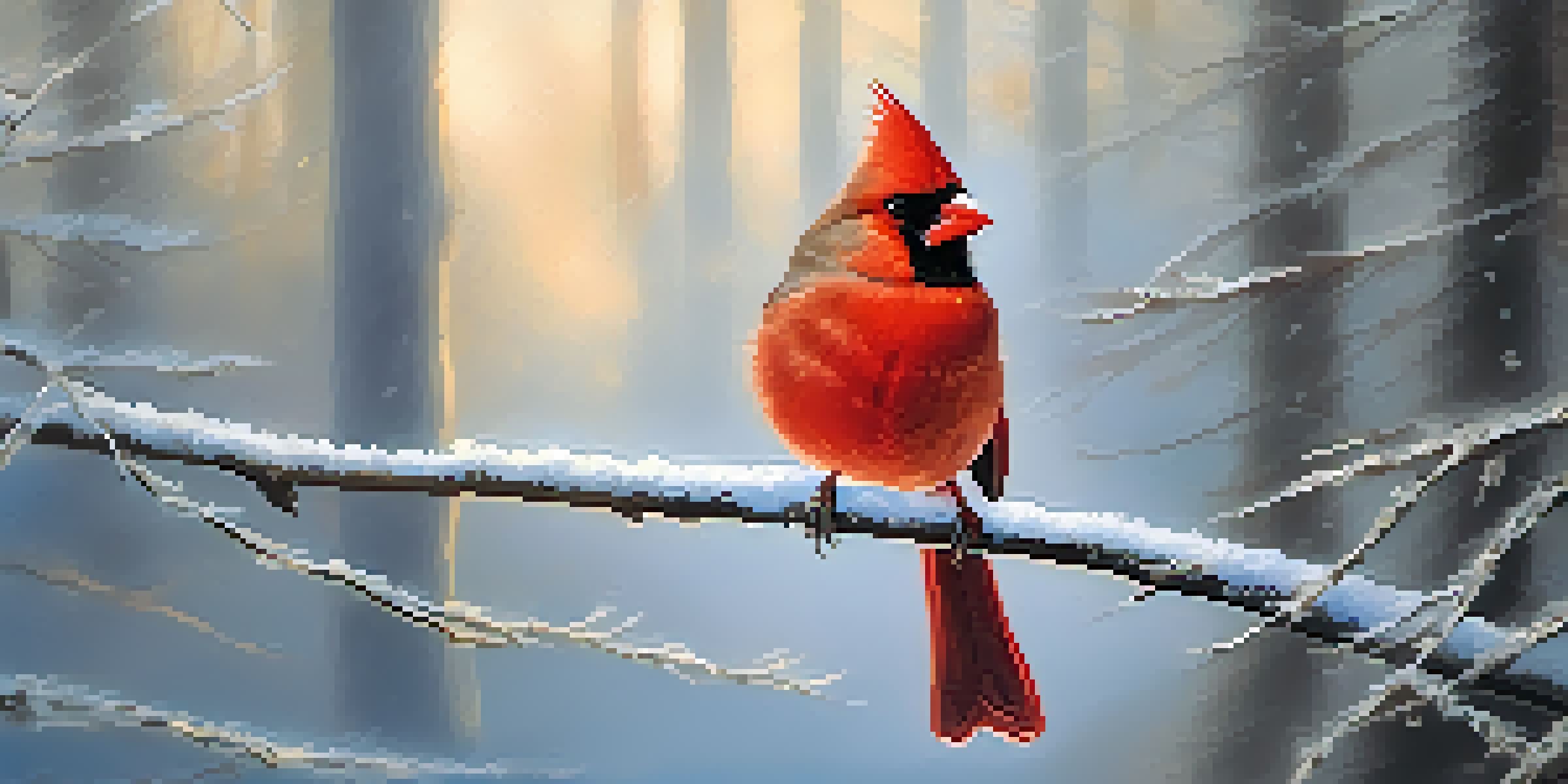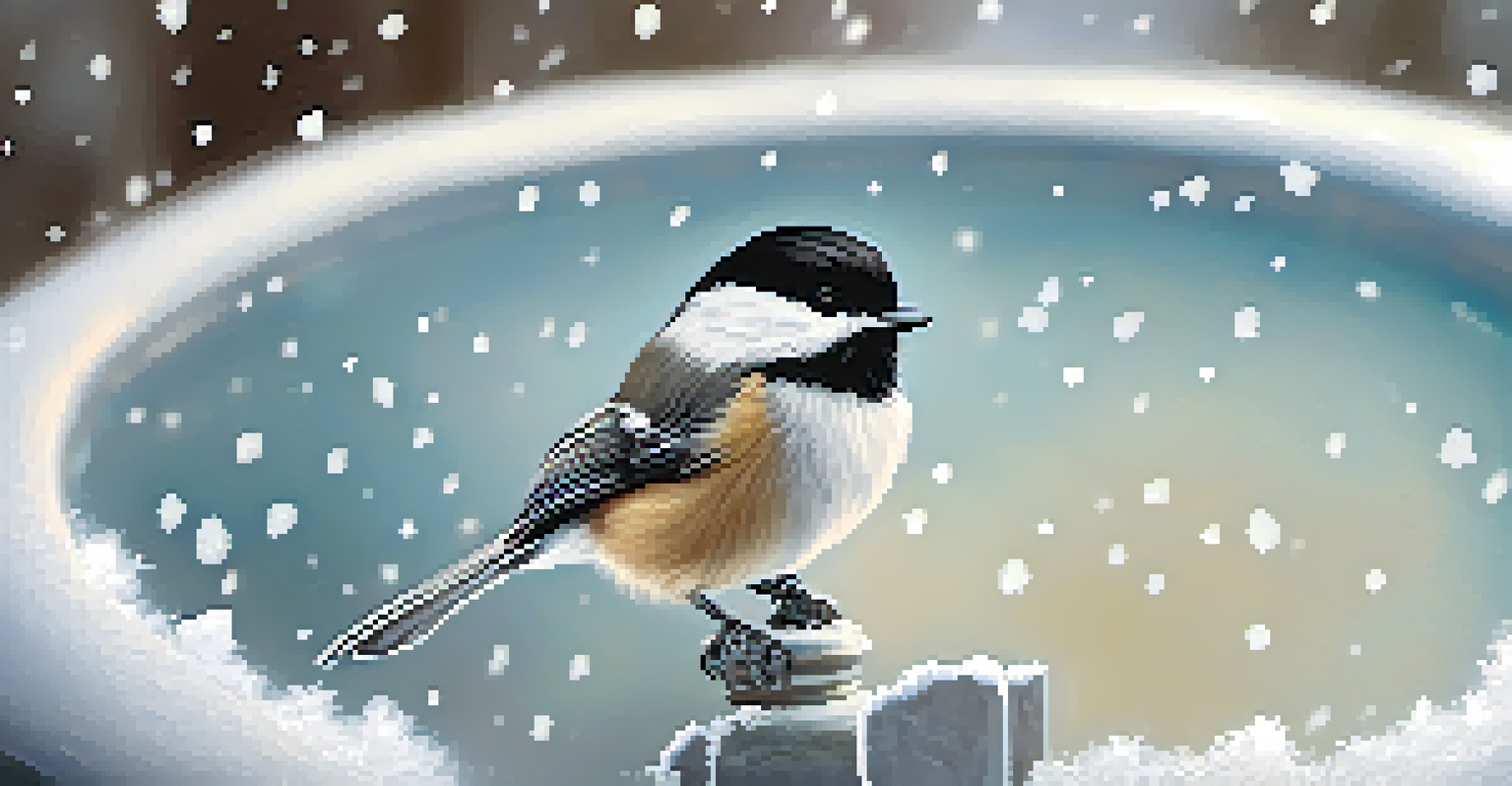Winter Birdwatching: Species to Look for in Cold Months

Understanding Winter Birdwatching Basics
Winter birdwatching can be a magical experience, as many species adapt uniquely to the cold months. This season often brings a different set of visitors to your backyard or local park. With a bit of preparation, you can enjoy the beauty of birds that thrive in winter conditions.
In winter, the birds are all still there, but they’re in a different place. They're right here, and it’s up to you to find them.
The key to successful winter birdwatching lies in understanding the behaviors and habitats of these species. Many birds migrate south for the winter, but others remain, taking advantage of the food sources available. Knowing where to look and what to expect can enhance your birdwatching experience.
As you embark on your winter birdwatching adventure, be sure to dress warmly and bring along some essential gear. Binoculars, a field guide, and a notebook for observations can make all the difference. With the right tools, you're ready to discover the vibrant world of winter birds.
Essential Gear for Winter Birdwatching
When heading out into the chilly air, it’s crucial to have the right gear to keep you warm and enhance your birdwatching experience. A good pair of insulated boots and layered clothing will keep you comfortable despite the cold. Don’t forget gloves that allow for dexterity, so you can easily handle your binoculars and camera.

In addition to attire, consider bringing along a quality pair of binoculars. A magnification of 8x to 10x is ideal for birdwatching, allowing you to observe distant birds without disturbing them. A compact field guide can also be invaluable, helping you identify species on the spot.
Prepare for Winter Birdwatching
Dressing warmly and bringing essential gear like binoculars and a field guide can significantly enhance your winter birdwatching experience.
Lastly, a notebook or mobile app can be used to document your sightings. Recording your observations not only helps you remember the birds you’ve seen but also tracks changes in local populations over time. This simple act can deepen your connection to the avian world.
Common Winter Birds to Watch For
As winter settles in, certain birds become more prominent in our neighborhoods and parks. Some of the most common winter visitors include cardinals, juncos, and chickadees. Their vibrant colors and distinctive calls can brighten even the gloomiest of winter days.
Birdwatching is not just an activity; it’s an invitation to connect with nature and appreciate the resilience of life, even in the coldest seasons.
Cardinals, with their bright red plumage, are often spotted at feeders and in bushes. Their cheerful song adds a lively soundtrack to the winter landscape. Meanwhile, juncos, with their slate-gray bodies, tend to forage on the ground, making them a delightful sight.
Chickadees, known for their curious nature and distinctive 'chick-a-dee-dee-dee' call, are quite friendly and often visit feeders frequently. Observing their behavior can be a joy, as they flit about with energy and enthusiasm. These birds, along with many others, make winter birdwatching a rewarding hobby.
Unique Adaptations of Winter Birds
Winter birds have fascinating adaptations that help them survive the cold. For instance, many species develop extra layers of feathers to insulate their bodies. This helps them retain body heat, even in frigid temperatures.
Some birds also change their feeding habits in winter, relying more on seeds and berries than insects. For example, woodpeckers and nuthatches use their strong beaks to access food hidden in tree bark. This ability to adapt their diet is crucial for survival during the colder months.
Feed Birds to Attract Them
Providing food sources such as bird feeders filled with seeds and suet can create a lively environment for winter birdwatching right in your backyard.
Additionally, many birds have a remarkable ability to enter a state called torpor. This temporary hibernation-like state allows them to conserve energy during the coldest nights. Understanding these adaptations deepens our appreciation for the resilience of winter birds.
Feeding Birds in Winter: Tips and Tricks
One of the best ways to attract birds to your yard during winter is by providing food. Setting up a bird feeder filled with seeds, suet, or nuts can create a lively birdwatching spot right outside your window. Black-oil sunflower seeds are particularly popular among many species.
In addition to feeders, consider planting native shrubs that produce berries in the winter. These natural food sources can attract a variety of birds looking for nourishment. Providing water, even in freezing temperatures, can also be beneficial; a heated birdbath is a great investment.
Remember to keep your feeders clean and refilled regularly. This not only supports the birds but also minimizes the risk of spreading diseases among them. By maintaining a reliable food supply, you'll be rewarded with the lively presence of various winter bird species.
Best Locations for Winter Birdwatching
Finding the right locations can significantly enhance your winter birdwatching experience. Local parks, nature reserves, and even your backyard can be ideal spots to observe winter birds. Each location offers unique opportunities to see different species.
Wetlands and open fields are particularly attractive to birds during winter, as they provide abundant food sources. Waterfowl, such as ducks and geese, often gather in these areas, making them a prime location for birdwatchers. Similarly, forested areas attract woodpeckers, nuthatches, and other woodland species.
Respect Birdwatching Etiquette
Maintaining a respectful distance and avoiding flash photography ensures that you enjoy observing birds without disturbing their natural behaviors.
Don't overlook urban areas, as they can be surprisingly rich in birdlife. Many birds thrive in city parks or green spaces, taking advantage of feeders and gardens. Exploring these diverse environments can reveal a wealth of winter bird species.
Enjoying the Experience: Birdwatching Etiquette
As you venture out to watch birds this winter, it's essential to practice good birdwatching etiquette. Keeping a respectful distance from birds ensures that you don’t disturb their natural behaviors. This is especially important during the winter months when they expend extra energy to survive.
Additionally, it’s good practice to avoid using flash photography, as it can startle birds and disrupt their activities. Instead, consider using natural light and being patient to capture those perfect moments. Remember, the goal is to enjoy and appreciate these beautiful creatures in their habitat.

Lastly, consider sharing your knowledge and experiences with others. Whether through social media or local birdwatching groups, fostering a community around birdwatching can enhance the experience for everyone involved. Together, we can celebrate and protect our feathered friends.